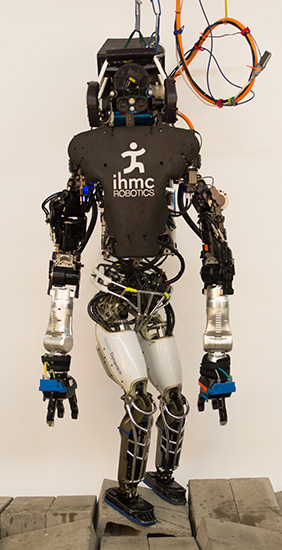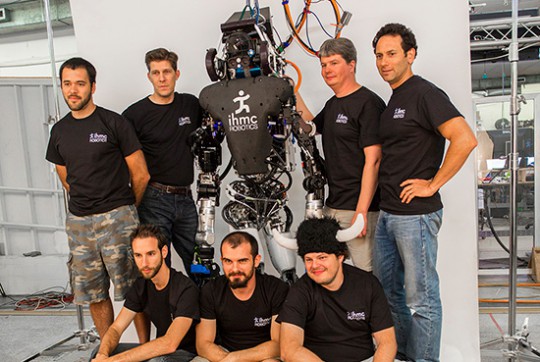Local Robotics Teams Places 2nd, Claims $1 Million Prize, In Global Contest
June 8, 2015
Three years of almost non-stop work paid off Saturday when the Florida Institute for Human and Machine Cognition of Escambia County placed second — and claimed a $1 million prize – in a $3.5 million global robotics competition held in Pomona, Calif.
Team IHMC’s semi-autonomous robot, nicknamed “Running Man,” on Saturday bested 21 other teams from around the world by driving a car, walking over debris, cutting a hole in a wall, turning a valve for a fire hose and climbing stairs — all with spotty communications between man and machine. The course simulated a disaster area in which humans could not safely operate.
“I am incredibly proud of our robotics team,” said IHMC CEO/Director Ken Ford. “They did an amazing job finishing second overall and were first among the Atlas teams.”
 The Robotics Challenge, the third and final trial since 2013, was sponsored by DARPA, the Defense Advance Research Projects Agency. The first-place team, Team KAIST from South Korea, was awarded $2 million. It also completed all eight tasks, but did so six minutes faster than the IHMC robot. IHMC, which finished the course in just over 50 minutes Saturday, will bring home $1 million in prize money. A chimp-like robot from Carnegie Mellon University
The Robotics Challenge, the third and final trial since 2013, was sponsored by DARPA, the Defense Advance Research Projects Agency. The first-place team, Team KAIST from South Korea, was awarded $2 million. It also completed all eight tasks, but did so six minutes faster than the IHMC robot. IHMC, which finished the course in just over 50 minutes Saturday, will bring home $1 million in prize money. A chimp-like robot from Carnegie Mellon University
placed third. Only three teams completed all eight tasks.
Unlike some of the other robots, which moved on wheels or four legs, IHMC’s machine employed a large, bipedal machine known as an Atlas robot that had to walk on two legs. After it fell twice Friday in its first run through the course, IHMC’s 23-member team worked through the night to resolve the problems and replace part of an arm and a leg.
“It was pretty damaged after Friday’s falls, so we had to take it slow today,” IHMC computer scientist and team member Doug Stephen said Saturday night. “Part of the physical structure was bent, so it was throwing off some of the alignment. So we didn’t think we’d get even two tasks done today, much less all eight.”
“Everyone is over the moon now,” Stephen said. “We’re super-happy.”
Organizers of the much-anticipated event said the advances made by IHMC and other teams mark the start of a new era in the science of robotics.
Humans “get most of our ideas about robotics from science fiction. (Today) we want to show a little bit of science fact,” Gill Pratt, director of the event, told the Associated Press. While Hollywood has portrayed robots as agile and self-thinking, the machines are only now beginning to make strides toward that ideal, and the competition was designed to push the research forward, organizers said.
The 6-foot, 2-inch Atlas robot used by IHMC was built by Boston Dynamics. But the software and controls were produced by institute researchers Jerry Pratt, John Carff, Peter Neuhaus, Matt Johnson and others. After the second round of the robotics challenge in late 2013, that software was considered so robust that DARPA asked that other teams be allowed to use it.
“Some of the other teams’ software would just let them say, ‘move here,’” said Carff, who was primary operator of the IHMC robot. “With ours, we could put a virtual arm out in the world, and we can see where that virtual arm is going to go, we can preview the path it’s going to take, and we can say, ‘Yes, that’s not going to collide with anything, so go for it.’”
In keeping with IHMC’s core principles, the software ensures a high degree of collaboration between the human operators and the machine by “providing bi-directional information exchange,” according to an academic paper authored by the team members. The robot may suggest a move, but that suggestion can be verified by human operators.
The challenge has been a great learning experience for IHMC’s team and the entire field of robotics, team members said.
“All we can do is do the best research we can do,” Stephen said. “It’s not about beating the other teams as it is advancing the research and sharing that with the world.”
IHMC team members are expected to take some much-needed time off this summer before turning to other robotics projects.




Comments